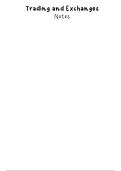Summary
Summary Course Notes Trading and Exchanges
- Course
- Institution
This document provides all the notes and the material that was handled in 'all' the lectures in the year 2023/2024. This document should be enough to understand the exam material.
[Show more]



